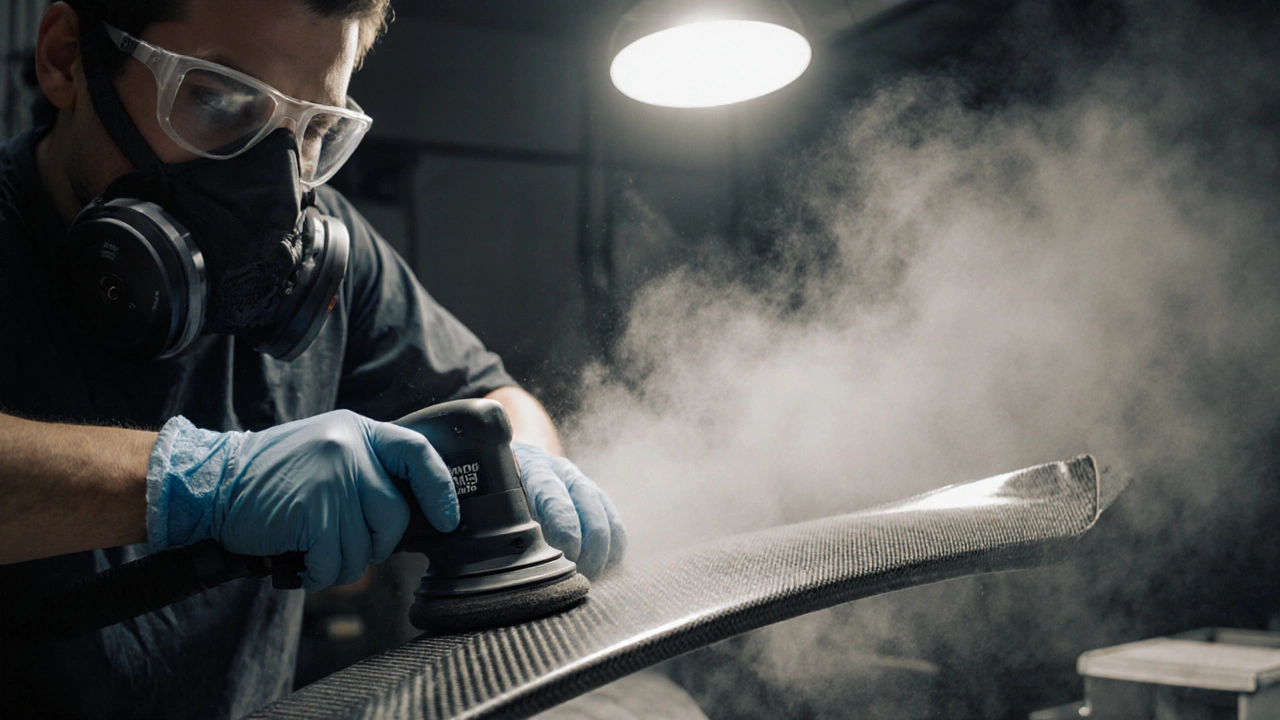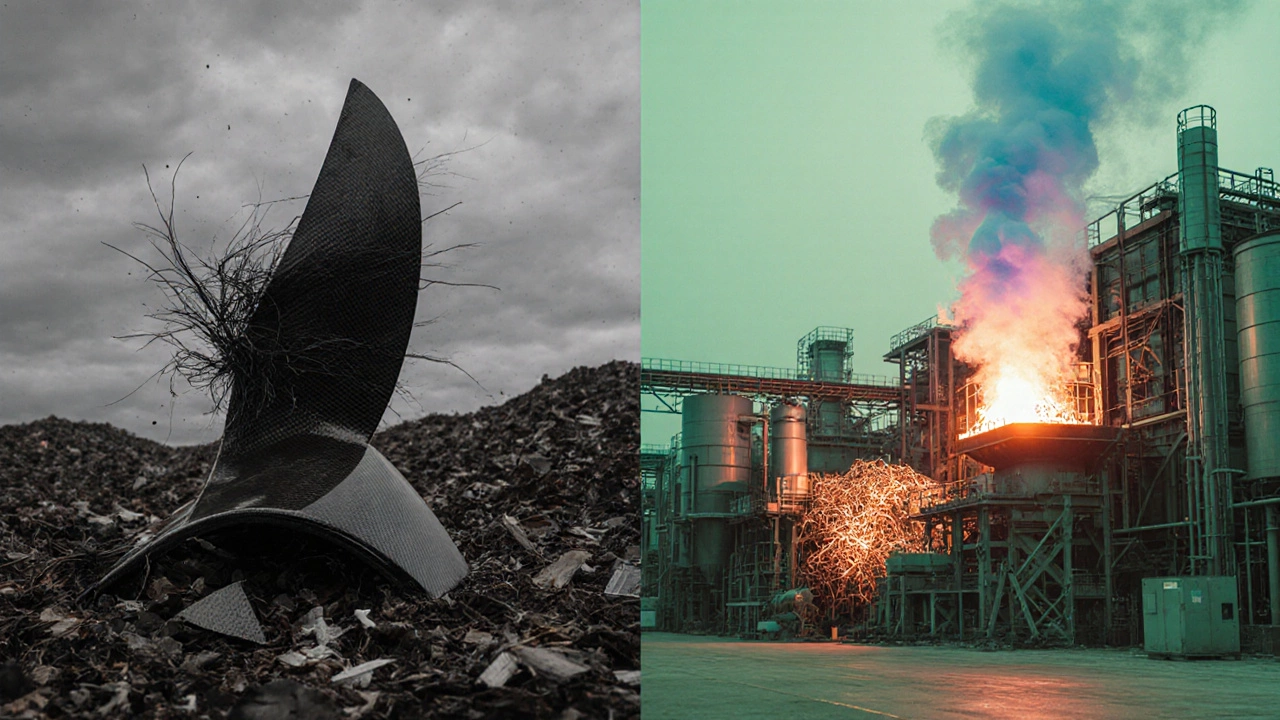Carbon Fiber Spoiler Impact Calculator
Risk Assessment
When you spot a glossy, black spoiler on a sports car, you probably assume it looks cool and adds downforce. Most of those sleek wings are made from carbon fiber, a composite praised for being light and strong. But the negative effects of carbon fiber are often hidden behind the glossy finish. Below we unpack the health, safety, and environmental downsides you should know before you slap a carbon‑fiber spoiler on your ride.
Key Takeaways
- Carbon‑fiber dust can irritate lungs and skin; proper PPE is a must during sanding or cutting.
- Improperly cured or damaged spoilers may shatter on impact, posing a safety hazard.
- Manufacturing carbon fiber consumes a lot of energy and produces non‑biodegradable waste.
- Recycling options exist but are costly and limited compared to metals or fiberglass.
- Choosing alternatives like aluminum or fiberglass can reduce health and environmental risks, though each material has its own trade‑offs.
What Is Carbon Fiber?
Carbon fiber is a reinforced polymer composite consisting of thin strands of carbon atoms arranged in a crystalline structure. These strands are woven into a fabric and bonded with an epoxy resin to form a rigid panel. The result: a material with a high strength‑to‑weight ratio, excellent stiffness, and a distinctive matte black finish.
Why Carbon Fiber Is Popular for Spoilers
Automotive engineers love carbon fiber because a lightweight spoiler adds downforce without the penalty of extra mass. In performance circles, a automotive spoiler made of carbon fiber can shave seconds off a lap time. The material also allows complex aerodynamic shapes that would be difficult to achieve with metal stamping.
Health Risks: Dust, Fibers, and Skin
When you cut, sand, or drill carbon fiber, a fine dust is released. This dust consists of tiny reinforcement fibers that are biologically inert but mechanically irritating. Inhalation can cause:
- Short‑term coughing, throat irritation, and eye watering.
- Long‑term exposure may lead to chronic bronchitis or reduced lung function, similar to silica dust.
Skin contact with the dust can cause abrasions and allergic reactions for some individuals. The Occupational Safety and Health Administration (OSHA) classifies carbon‑fiber dust as a “respirable particulate” that requires respiratory protection in occupational settings.

Safety Concerns: Structural Failure and Fire
Although carbon fiber is strong, it is also brittle. A poorly manufactured or damaged spoiler can crack under high impact or extreme temperature changes. When a crack propagates, the material can shatter, sending sharp fragments into the vehicle’s cabin - a real safety hazard during a crash.
Carbon fiber also has a low ignition temperature compared to metals. If a fire reaches the spoiler, the epoxy resin can melt and release volatile organic compounds (VOCs), which are toxic when inhaled. In a high‑performance car where exhaust gases are already hot, this risk becomes more pronounced.
Environmental Impact: Production, Waste, and Recycling
Producing carbon fiber is energy‑intensive. According to a 2024 report by the Carbon Fiber Consortium, manufacturing one kilogram of carbon fiber consumes about 150kWh of electricity and emits roughly 20kg of CO₂. The raw material-polyacrylonitrile (PAN)-is derived from petroleum, adding a fossil‑fuel footprint.
End‑of‑life disposal is another issue. Carbon‑fiber composites are not biodegradable, and landfilling them occupies space without breaking down. Recycling is possible through processes like pyrolysis or mechanical grinding, but these methods are costly and not widely available. As a result, many used spoilers end up in landfill, contributing to long‑term environmental contamination.
How Carbon Fiber Stacks Up Against Alternatives
| Attribute | Carbon Fiber | Fiberglass | Aluminum |
|---|---|---|---|
| Density (g/cm³) | 1.6 | 2.5 | 2.7 |
| Tensile Strength (MPa) | 3,500-6,000 | 350-750 | 310-550 |
| Cost (USD per kg) | ≈$70-$100 | ≈$5-$10 | ≈$3-$5 |
| Manufacturing Energy (kWh/kg) | ≈150 | ≈30 | ≈10 |
| Recyclability | Low - expensive processes | Moderate - can be melted | High - scrap metal market |
| Health Risks (dust) | Respirable fibers, skin irritation | Silica particles, lower irritancy | Metal shavings, less inhalable |
From the table you can see that carbon fiber wins on performance but loses on cost, energy use, and recyclability. Fiberglass offers a middle ground: it’s heavier than carbon fiber but cheaper and easier to recycle. Aluminum is the most recyclable and cheap but adds weight, which can negate the aerodynamic benefits.

Mitigation Strategies: Safe Handling and End‑of‑Life Planning
If you’re determined to install a carbon‑fiber spoiler, follow these steps to reduce the downsides:
- Wear proper protective equipment: Use a NIOSH‑approved respirator (rated P100), safety glasses, and disposable gloves when cutting or sanding.
- Work in a well‑ventilated area or use local exhaust ventilation to capture dust.
- Inspect the spoiler regularly for cracks, delamination, or signs of impact damage.
- If a crack appears, replace the part promptly - carbon‑fiber fragments can become projectiles.
- Choose a supplier that offers a take‑back recycling program or works with a certified pyrolysis facility.
- Consider a protective clear coat that can reduce dust generation during routine cleaning.
For manufacturers, adopting greener processes such as low‑temperature curing or using bio‑based resins can shrink the carbon footprint. Some European firms are already testing recycled carbon fiber blends that retain up to 80% of the original strength while cutting waste by half.
Frequently Asked Questions
Is carbon‑fiber dust as dangerous as asbestos?
No, carbon‑fiber dust does not have the same carcinogenic properties as asbestos. However, it is still a respirable particulate that can cause irritation and long‑term lung issues if inhaled regularly. Protective gear is recommended during any machining.
Can a carbon‑fiber spoiler melt in a fire?
The epoxy resin can soften and burn at temperatures above 300°C, releasing toxic fumes. The carbon fibers themselves won’t melt but can degrade, compromising structural integrity.
What’s the best way to recycle a carbon‑fiber spoiler?
Mechanical grinding into short fibers for use in lower‑performance parts is the most common method. Pyrolysis can recover fibers and resin, but it’s expensive and not widely available. Look for manufacturers that accept end‑of‑life returns.
Are there any health‑friendly alternatives to carbon fiber for spoilers?
Fiberglass and aluminum are the most common alternatives. Fiberglass is heavier but easier to work with and recycle. Aluminum offers the highest recyclability and low dust hazards but adds weight, affecting performance.
Does a carbon‑fiber spoiler improve fuel efficiency?
Only marginally. The weight savings are usually under 2kg, which translates to less than 0.5% improvement in fuel economy. Most of the benefit comes from aerodynamic downforce, not weight reduction.
Next Steps for Car Enthusiasts
If you’ve weighed the pros and cons and still want a carbon‑fiber spoiler, start by finding a reputable installer who follows safety protocols. Ask them about dust‑capture systems and whether they provide a warranty against delamination. For those looking to go greener, explore suppliers offering recycled‑carbon options or consider switching to a high‑quality fiberglass wing that still delivers a sporty look with fewer health and environmental concerns.






